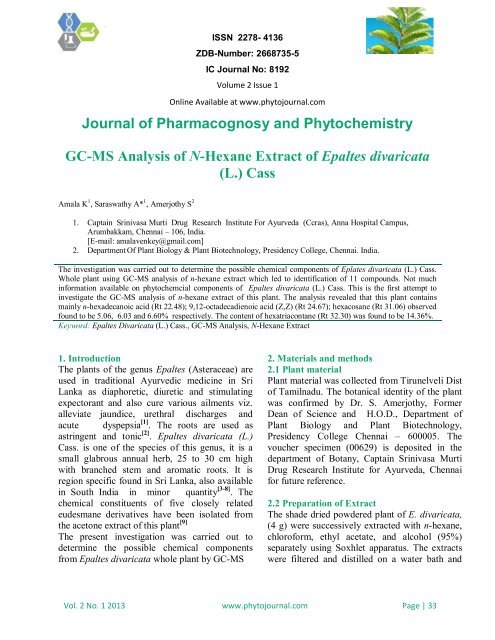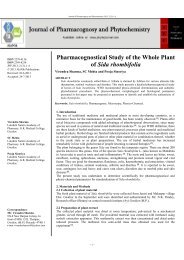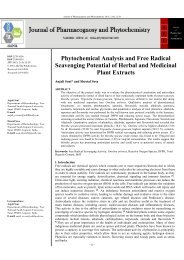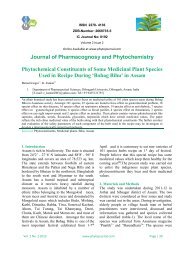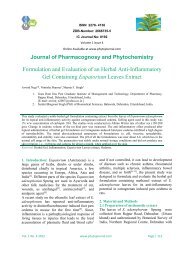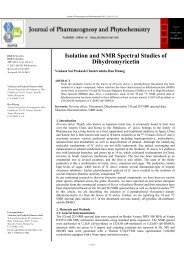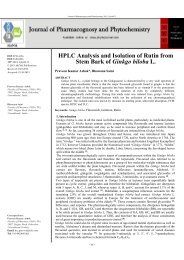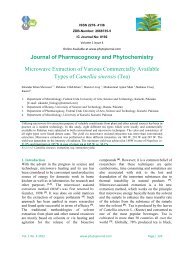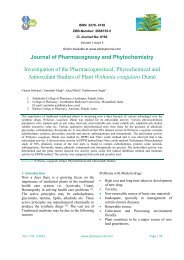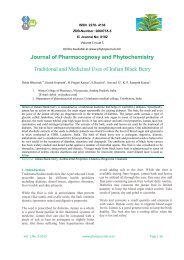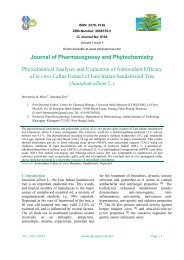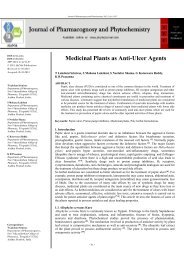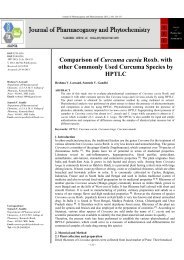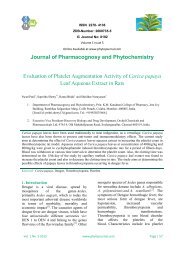GC-MS Analysis of N-Hexane Extract of Epaltes divaricata
GC-MS Analysis of N-Hexane Extract of Epaltes divaricata
GC-MS Analysis of N-Hexane Extract of Epaltes divaricata
You also want an ePaper? Increase the reach of your titles
YUMPU automatically turns print PDFs into web optimized ePapers that Google loves.
ISSN 2278- 4136<br />
ZDB-Number: 2668735-5<br />
IC Journal No: 8192<br />
Volume 2 Issue 1<br />
Online Available at www.phytojournal.com<br />
Journal <strong>of</strong> Pharmacognosy and Phytochemistry<br />
<strong>GC</strong>-<strong>MS</strong> <strong>Analysis</strong> <strong>of</strong> N-<strong>Hexane</strong> <strong>Extract</strong> <strong>of</strong> <strong>Epaltes</strong> <strong>divaricata</strong><br />
(L.) Cass<br />
Amala K 1 , Saraswathy A* 1 , Amerjothy S 2<br />
1. Captain Srinivasa Murti Drug Research Institute For Ayurveda (Ccras), Anna Hospital Campus,<br />
Arumbakkam, Chennai – 106, India.<br />
[E-mail: amalavenkey@gmail.com]<br />
2. Department Of Plant Biology & Plant Biotechnology, Presidency College, Chennai. India.<br />
The investigation was carried out to determine the possible chemical components <strong>of</strong> Eplates <strong>divaricata</strong> (L.) Cass.<br />
Whole plant using <strong>GC</strong>-<strong>MS</strong> analysis <strong>of</strong> n-hexane extract which led to identification <strong>of</strong> 11 compounds. Not much<br />
information available on phytochemcial components <strong>of</strong> <strong>Epaltes</strong> <strong>divaricata</strong> (L.) Cass. This is the first attempt to<br />
investigate the <strong>GC</strong>-<strong>MS</strong> analysis <strong>of</strong> n-hexane extract <strong>of</strong> this plant. The analysis revealed that this plant contains<br />
mainly n-hexadecanoic acid (Rt 22.48); 9,12-octadecadienoic acid (Z,Z) (Rt 24.67); hexacosane (Rt 31.06) observed<br />
found to be 5.06, 6.03 and 6.60% respectively. The content <strong>of</strong> hexatriacontane (Rt 32.30) was found to be 14.36%.<br />
Keyword: <strong>Epaltes</strong> Divaricata (L.) Cass., <strong>GC</strong>-<strong>MS</strong> <strong>Analysis</strong>, N-<strong>Hexane</strong> <strong>Extract</strong><br />
1. Introduction<br />
The plants <strong>of</strong> the genus <strong>Epaltes</strong> (Asteraceae) are<br />
used in traditional Ayurvedic medicine in Sri<br />
Lanka as diaphoretic, diuretic and stimulating<br />
expectorant and also cure various ailments viz.<br />
alleviate jaundice, urethral discharges and<br />
acute dyspepsia [1] . The roots are used as<br />
astringent and tonic [2] . <strong>Epaltes</strong> <strong>divaricata</strong> (L.)<br />
Cass. is one <strong>of</strong> the species <strong>of</strong> this genus, it is a<br />
small glabrous annual herb, 25 to 30 cm high<br />
with branched stem and aromatic roots. It is<br />
region specific found in Sri Lanka, also available<br />
in South India in minor quantity [3-8] . The<br />
chemical constituents <strong>of</strong> five closely related<br />
eudesmane derivatives have been isolated from<br />
the acetone extract <strong>of</strong> this plant [9]<br />
The present investigation was carried out to<br />
determine the possible chemical components<br />
from <strong>Epaltes</strong> <strong>divaricata</strong> whole plant by <strong>GC</strong>-<strong>MS</strong><br />
2. Materials and methods<br />
2.1 Plant material<br />
Plant material was collected from Tirunelveli Dist<br />
<strong>of</strong> Tamilnadu. The botanical identity <strong>of</strong> the plant<br />
was confirmed by Dr. S. Amerjothy, Former<br />
Dean <strong>of</strong> Science and H.O.D., Department <strong>of</strong><br />
Plant Biology and Plant Biotechnology,<br />
Presidency College Chennai – 600005. The<br />
voucher specimen (00629) is deposited in the<br />
department <strong>of</strong> Botany, Captain Srinivasa Murti<br />
Drug Research Institute for Ayurveda, Chennai<br />
for future reference.<br />
2.2 Preparation <strong>of</strong> <strong>Extract</strong><br />
The shade dried powdered plant <strong>of</strong> E. <strong>divaricata</strong>,<br />
(4 g) were successively extracted with n-hexane,<br />
chlor<strong>of</strong>orm, ethyl acetate, and alcohol (95%)<br />
separately using Soxhlet apparatus. The extracts<br />
were filtered and distilled on a water bath and<br />
Vol. 2 No. 1 2013 www.phytojournal.com Page | 33
Journal <strong>of</strong> Pharmacognosy and Phytochemistry<br />
finally dried in vacuo. The n-hexane extract <strong>of</strong><br />
the plant was used for <strong>GC</strong>-<strong>MS</strong> analysis.<br />
2.3 Instruments and Chromatographic<br />
Conditions<br />
Gas chromatography combined with mass<br />
spectroscopy is a preferable methodology for<br />
routine analysis <strong>of</strong> compounds. n-<strong>Hexane</strong> extract<br />
<strong>of</strong> the plant was injected into the Gas<br />
chromatography unit Shimadzu <strong>GC</strong>-<strong>MS</strong> QP2010<br />
was the instrument used for <strong>GC</strong>-<strong>MS</strong> analysis. It is<br />
separated into various constituents with different<br />
retention time which are detected by mass<br />
spectrophotometer. The chromatogram a plot <strong>of</strong><br />
intensity against retention time was recorded by<br />
the s<strong>of</strong>tware attached to it. From the graph the<br />
compounds are identified comparing the data<br />
with the existing s<strong>of</strong>tware libraries like<br />
WILEY08, NIST08 and NIST08s.<br />
1 l <strong>of</strong> the n-hexane extract <strong>of</strong> the plant was<br />
injected into <strong>GC</strong>. The injector temperature was<br />
maintained at 250ºC. The detector used was<br />
flame ionization detector which was maintained<br />
at 280ºC. The pressure <strong>of</strong> the carrier gas,<br />
nitrogen was kept at 10 psi. The oven temperature<br />
was set at 60ºC to 280ºC with a gradual<br />
increment <strong>of</strong> 10ºC per min. The injected extracts<br />
was eluted in the DB-5 <strong>MS</strong> column <strong>of</strong> 30 m long<br />
and 0.25 mm inner diameter and the eluted<br />
constituents were detected by flame ionization<br />
detector and the <strong>GC</strong> chromatogram was recorded.<br />
3. Results and Discussion<br />
3.1 <strong>GC</strong>-<strong>MS</strong> analysis<br />
GS-<strong>MS</strong> chromatogram <strong>of</strong> the n-hexane extract<br />
study showed 11 peaks in E. <strong>divaricata</strong>, besides a<br />
number <strong>of</strong> peaks with very narrow retention time.<br />
The fragmentation patterns for some <strong>of</strong> the<br />
peaks were compared with that <strong>of</strong> the library<br />
<strong>of</strong> compounds. The n-hexane extract constituents<br />
along with their retention time and percentage<br />
area and superimposibility obtained from the <strong>GC</strong>-<br />
<strong>MS</strong> analyzer are tabulated in Table 1 and Fig. 1.<br />
Table 1: <strong>GC</strong>-<strong>MS</strong> Data <strong>of</strong> n-hexane extract <strong>of</strong> E. divaricate<br />
Retention time (Min.) Compound name Area % Super imposibility %<br />
9.033 Hexadecane 1.13 93<br />
13.542 n-Eicosane 1.19 93<br />
19.933 Neophytadiene 0.75 96<br />
21.375 Tetratriacontane 1.14 89<br />
21.975 n-Hexadecanoic acid 5.06 94<br />
22.483 Ethyl Hexadecanoate 1.30 93<br />
24.675 9,12-Octadecadienoic acid (Z,Z) 6.03 96<br />
31.067 Hexacosane 6.60 97<br />
32.300 n-Hexatriacontane 14.36 96<br />
The <strong>GC</strong>/<strong>MS</strong> pr<strong>of</strong>iles were used and identified<br />
eleven constituents in E. <strong>divaricata</strong>. The<br />
percentage content <strong>of</strong> compounds are n-<br />
hexadecanoic acid (Rt 21.97); 9,12-<br />
octadecadienoic acid (Z,Z) (Rt 24.67);<br />
hexacosane (Rt 31.06) observed found to be 5.06,<br />
6.03 and 6.60% respectively. Regarding the<br />
content <strong>of</strong> hexatriacontane (Rt 32.30) it was<br />
found to be 14.36%. Other constituents were <<br />
2%.<br />
Vol. 2 No. 1 2013 www.phytojournal.com Page | 34
Journal <strong>of</strong> Pharmacognosy and Phytochemistry<br />
Fig.1: <strong>GC</strong>-<strong>MS</strong> chromatogram <strong>of</strong> the n-hexane extract <strong>of</strong> E. divaricate<br />
4. Conclusion<br />
In the present study eleven chemical constituents<br />
have been identified from n-hexane extract <strong>of</strong> the<br />
whole plant <strong>of</strong> <strong>Epaltes</strong> <strong>divaricata</strong> by Gas<br />
Chromatogram Mass spectrometry (<strong>GC</strong>-<strong>MS</strong>)<br />
analysis. The presence <strong>of</strong> various phytochemicals<br />
contributes to the medicinal activity <strong>of</strong> the plant.<br />
5. References<br />
1. Hewawasam R.P, Jayatilaka KAPW, Pathirana<br />
and Muddduwa LKB. Hepatoprotective effect<br />
<strong>of</strong> <strong>Epaltes</strong> <strong>divaricata</strong> extract on carbon<br />
tetrachloride induced hepatotoxixity in mice.<br />
Ind. J. Med. Res 2004; 120: 30-34.<br />
2. Anonymous. The Wealth <strong>of</strong> India, A<br />
Dictionary <strong>of</strong> Indian Raw materials and<br />
Industrial products,<br />
3. Publication and Information Directorate,<br />
Council <strong>of</strong> Scientific and Industrial<br />
Research, New Delhi, 1952;<br />
4. Vol. III; 177.<br />
5. Cooke T. C.I.E. The flora <strong>of</strong> Presidency <strong>of</strong><br />
Bombay, Botanical survey <strong>of</strong> India, 1906; Vol.<br />
II; 83.<br />
6. Gamble J.S. Flora <strong>of</strong> Presidency <strong>of</strong> Madras.<br />
Botanical Survey <strong>of</strong> India, Calcutta, 1967; Vol.<br />
II; 485.<br />
7. Hooker J.D. Flora <strong>of</strong> British India, Botanical<br />
Survey <strong>of</strong> India, Calcutta, 1882; Vol. III; 274.<br />
8. Mathew KM. An exclusive flora <strong>of</strong> Central<br />
Tamil Nadu, The Ranipat Herbarium, St.<br />
John’s College, Tiruchirapalli, India, Published<br />
by CRC press, 1995; 259.<br />
9. Mayuranathan PV. The flowering plants <strong>of</strong><br />
Madras city and its immediate neibourhood.<br />
Revised by Livingstone C and Henry AN.<br />
New series-Natural History Section, 1994; Vol.<br />
X; 153.<br />
10. Pullaiah T, Sri Ramamurthy K and<br />
Karuppusamy. S. Flora <strong>of</strong> Eastern Ghats, Hill<br />
11. Ranges <strong>of</strong> South East India, 2001; Vol. III; 264.<br />
12. Rojatkar SR, Puranik VG, Tavale SS, Guru, Row<br />
TN and Nagasampagi BA. Eudesmane<br />
derivatives from <strong>Epaltes</strong> <strong>divaricata</strong>.<br />
Phytochemistry, 1987; 26: 569-70.<br />
Vol. 2 No. 1 2013 www.phytojournal.com Page | 35


